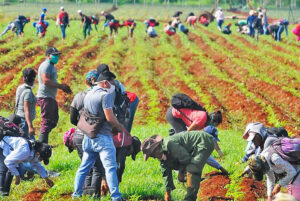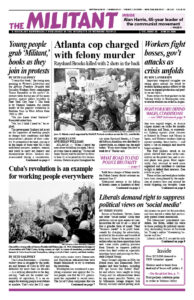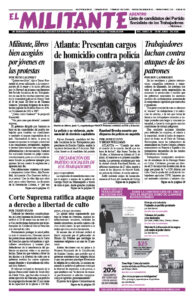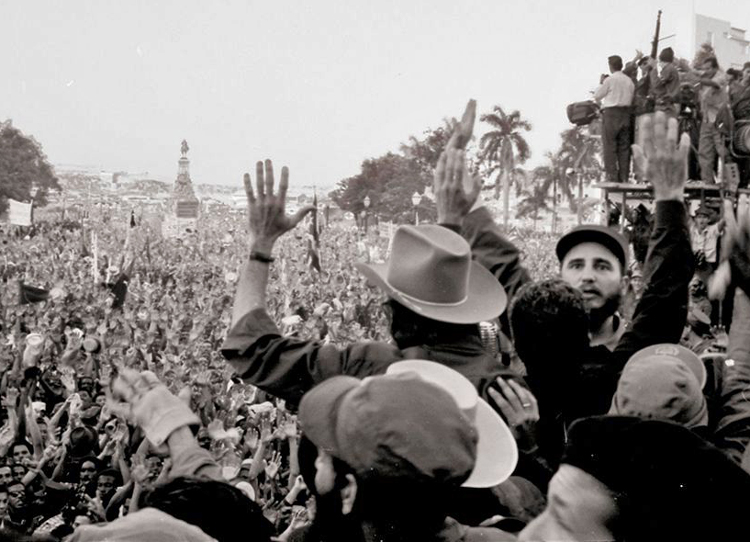The Cuban Revolution — a historic victory won in struggle by the workers and farmers of Cuba in 1959 and defended for more than six decades — is a striking alternative to the dog-eat-dog, “look out for number one” morality of capitalism. It is an example for working people everywhere to emulate. That’s why the U.S. capitalist rulers under every Democratic and Republican administration have fought relentlessly to try to overturn the revolution.
Washington has maintained a punishing economic war against the Cuban people, one that the U.S. government has expanded in recent years. The list of Cuban companies that are banned from doing any business with the U.S. has grown. Marriott International officials announced June 5 that U.S. officials ordered them to end all hotel operations in Cuba.

An island nation of 11.5 million people, Cuba has to import most of its oil, some 60% of its food, and much of the basic materials it needs for agriculture, such as fertilizer. Under U.S. sanctions, a lot of its industrial machinery is antiquated, kept running only by workers’ ingenuity.
Despite all this, workers and farmers in Cuba are making progress in increasing food production at the same time that they have pushed back the spread of coronavirus.
Cuba’s success in combating the spread of the virus — like in meeting all challenges the revolution faces — is the result of the mobilization of working people and youth, led by their mass organizations. These include the CTC union federation, Federation of Cuban Women and neighborhood Committees for the Defense of the Revolution, working alongside Cuba’s preventive health care system.
Medical students have joined with thousands of other volunteers to carry out millions of home visits to make sure everyone on the island gets the medical attention they need. The Cuban government announced these visits will continue indefinitely.
Those who test positive or have symptoms are moved to special medical centers, where they are quarantined, fed and receive top-notch medical care, all at no cost.
This is an extension of how Cuban working people and their government organize medical care all the time. Clinics and doctors are based in working-class neighborhoods. Their goal is to prevent diseases, not just to try and catch up with them after they spread. Compare that to the U.S.!
At the same time, Cuba has sent 34 volunteer brigades, totaling 3,337 health care workers, to treat COVID-19 patients in 27 countries, from Italy to Haiti to South Africa. This is in addition to 50,000 volunteers already providing care around the world, a tradition of international solidarity that began in the first years of the revolution.
Proud of their internationalism, thousands of cheering people lined the streets of Havana when the first of those brigades — the 52 men and women who treated patients in Lombardy, Italy — returned to Cuba June 8.
“The empty streets, the curfews, many sick people, and without any treatment plan, many deaths, but here we are, waging the battle,” Leonardo Fernández, one of the doctors told the Cuban press about the conditions they faced in imperialist Italy. “It hurts a lot to see the listlessness of powerful governments in the face of such a calamity.”
Cuba’s accomplishments are only possible because workers and farmers waged a revolutionary struggle, led by Fidel Castro, that overthrew the U.S.-backed Batista dictatorship. In the course of the revolution — and the battles to deepen and extend it afterward — Cuban workers and farmers transformed themselves, throwing off the self-image and morality that capitalist society imposed on them, and established a workers and farmers government. Argentine-born Cuban revolutionary leader Che Guevara said they had embarked on creating no less than new men and women.
A revolutionary people organized to nationalize key sections of the economy — including large capitalist farms — and run them under workers control. Landless peasants were given land to farm. Small farmers were guaranteed they would not lose their land. One million Cubans learned to read and write, as the Cuban government organized young volunteers to spread across the island in an unprecedented literacy campaign.
Unlike in the capitalist world, at Castro’s initiative, health care was transformed, ceasing to be a commodity bought and sold, and becoming a human right.
‘First there must be a revolution’
Guevara got at the heart of what was involved in an Aug. 19, 1960, speech. “Almost everyone knows that a number of years ago I started out my career to be a doctor,” he said. “I dreamed of working tirelessly to achieve something that could really be put at the disposal of humanity, but that would be a personal triumph at the same time.”
But he realized that “the desire to sacrifice an entire lifetime to the noblest of ideals — all that is for naught if the effort is made alone, solitary, in some corner of Latin America, fighting against hostile governments and social conditions that permit no progress.”
In the course of the struggle in Cuba, he learned that “to be a revolutionary doctor, or to be a revolutionary, there must first be a revolution.”
With that spirit thousands of working people and youth in Cuba are joining volunteer brigades to boost agriculture today. They are fighting to increase industrial production and to challenge the bureaucratic obstacles they confront. Some 400 union members at the Las Terrazas tourism complex in Artemisa are now working at the nearby Los Graverán farm, spreading fertilizer, preparing fields and making irrigation ditches. “We’ve been moved to where we are most useful: producing food,” José Alberto Lamas, one of the workers, told Trabajadores.
They know their hard work is not going to benefit a handful of capitalist bosses, but to improve the lives of working people in Cuba and around the world.


